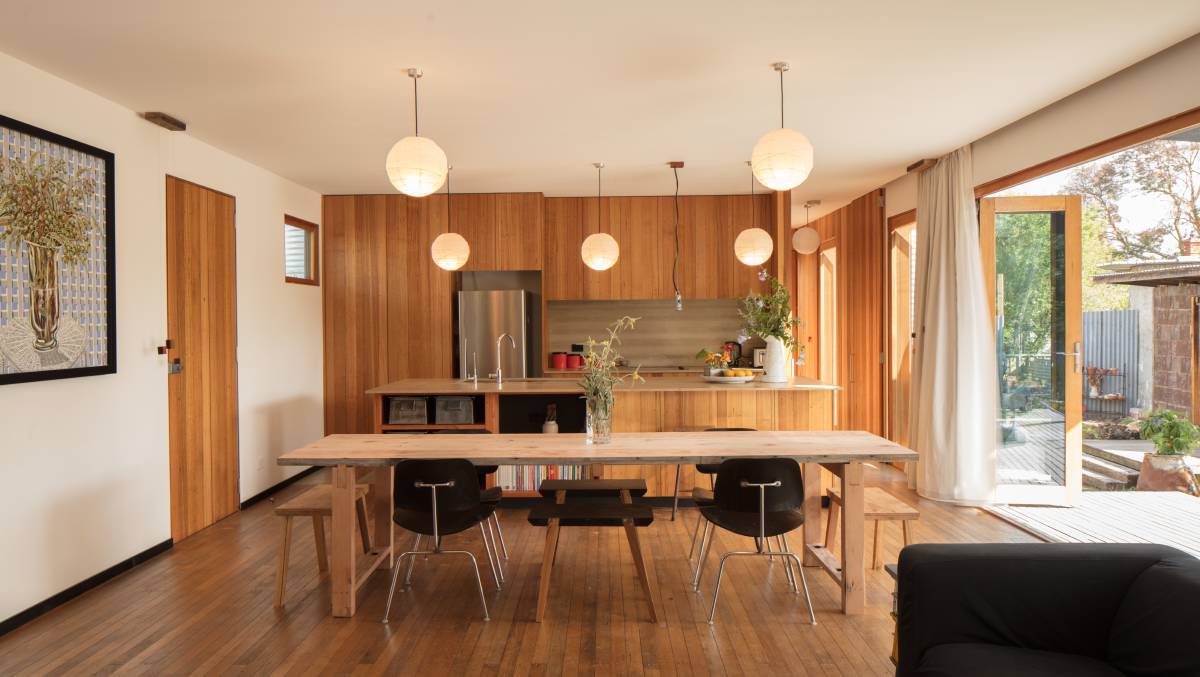A cutting-edge example of design and construction for recyclability, The Recyclable House was designed and built in 2015 by Quentin Irvine, managing director of Inquire Invent Pty Ltd.
Constructed in the regional Victorian town of Beaufort for Quentin’s family and now listed on Airbnb, The Recyclable House drew inspiration from iconic Australian galvanised steel woolsheds, handcrafts and industria. “Whilst learning the building profession I identified and became frustrated with the fact that most Australian homes are essentially built with/for rubbish, whether they were promoted as eco friendly homes or not,” says Quentin. “Even though materials were often coming to site as quality recyclable materials, they would be destined for landfill the minute that they were installed due to the building practices and installation methods used. I found solutions to many of these problems by researching older building methods as well as thinking creatively about the problem.”
Extensive research went into the design of the house for recyclability, made from recyclable materials that have been screwed and nailed together. Where glues/paints/sealants have been used, they are natural and biodegradable in all but a very few instances. The striking external facade is exceptionally low maintenance and durable, using Yakisugi (a traditional Japanese charred timber technique) on the north side, and heritage Z600 galvanised corrugated steel as the predominant external cladding, primarily for its superior durability and recyclability.
Quentin embraced a variety of mainstream building techniques and tweaked them as required to improve recyclability, thermal efficiency, building longevity and indoor air quality. This solar-passive and highly insulated design ensures warmth and comfort in Beaufort’s harsh winter. Like most sustainable houses, the house was designed with passive heating and cooling in mind. What sets it apart however, is the use of an experimental, closed loop design and construction methodology.
The walls are fully compostable, and Quentin says could ultimately enter the food chain. “By using the older style plaster board that was readily available in 2015, installing it without glue (screws only) and painting it with natural paint, you have a wall lining which is essentially: paper, gypsum and a few other inert ingredients” he says. “Assuming that these materials are not contaminated down the track, you have a wall lining that can be composted and used as a soil improver. You then get to eat the walls when your crop sets!”

THOROUGHLY RESEARCHED: The recyclable materials have been screwed and nailed together, and where glues, paints or sealants have been used, they are natural and biodegradable in all but a very few instances.
The bathrooms were built using similar techniques to roof building. “We started with recyclable and partly recycled cement sheet that we screwed to the floor structure,” says Quentin. “We then built waterproof, stainless steel floor trays/shower trays that had floor/shower wastes installed. These acted as the waterproofing layer. From here we used floating decking boards in one bathroom, and pebbles/ pavers in another. For a more conventional finish, you could use tiles on a sand/cement mortar bed for floors and still keep it fully recyclable.”
To create an entirely recyclable kitchen, PureBond Plywood (which uses formaldehyde free soy-based glues), Plaspanel (recycled plastic panel), and re-machined recycled timber dressed with natural oils and cement sheet were used. “All of these materials are recyclable and they were all screwed together so that they could be easily disassembled for recycling,” says Quentin.

SUSTAINABLE: To create an entirely recyclable kitchen, PureBond Plywood, recycled plastic panel and re-machined recycled timber dressed with natural oils and cement sheet were used.
While building an airtight home remains a popular quest, Quentin points out that using a common Australian aluminium/plastic-foil building wrap and filling every nook and cranny with an acrylic/ chemical filler and expanding polyurethane foam is not recyclable. Instead, recyclable polyester breather wrap was used for the house walls. “This is just as good for air tightness but is vapour permeable, therefore keeping the wall cavities and the home dryer, mould free and healthier,” says Quentin. Instead of smearing filler and expander foam all over the recyclable timber, correctly installed flashings and correctly lapped and stapled wall wrap were used to keep things as air tight as possible. Rock wool insulation then filled in any remaining tricky gaps.
The Recyclable House is an example of how the building industry can address the urgent issue of waste reduction and whole of life cycle resource management. The building’s practical utility and stylish appeal successfully marries design and construction in a way that provides solutions for housing in a circular economy.
